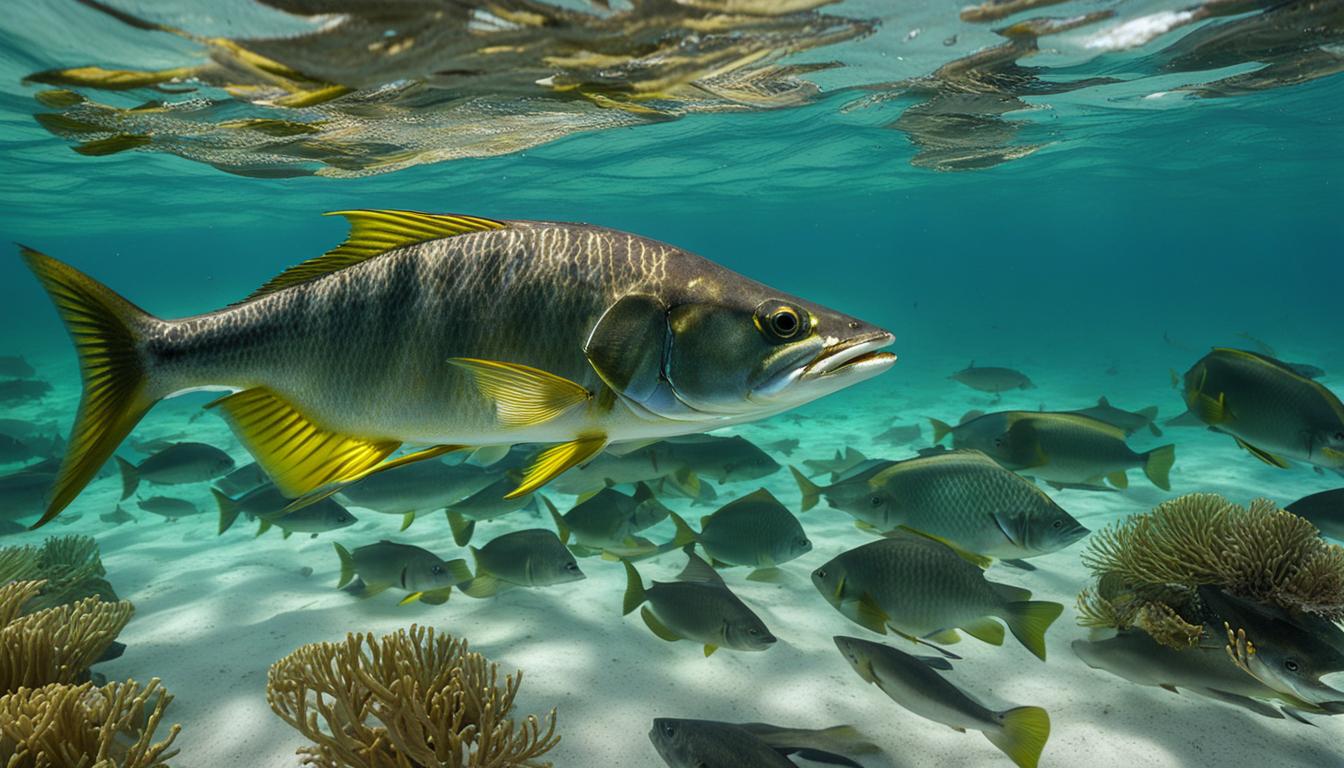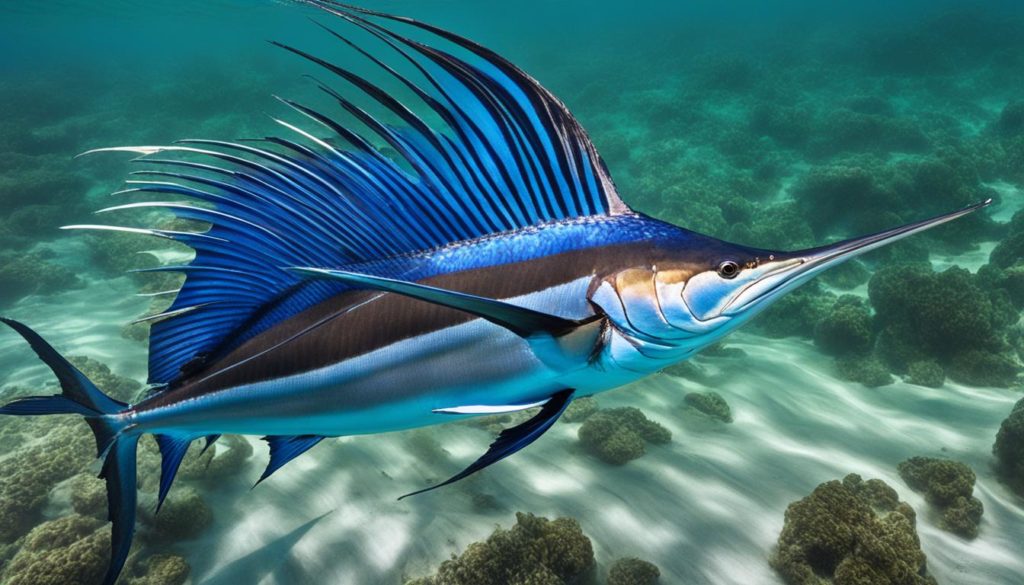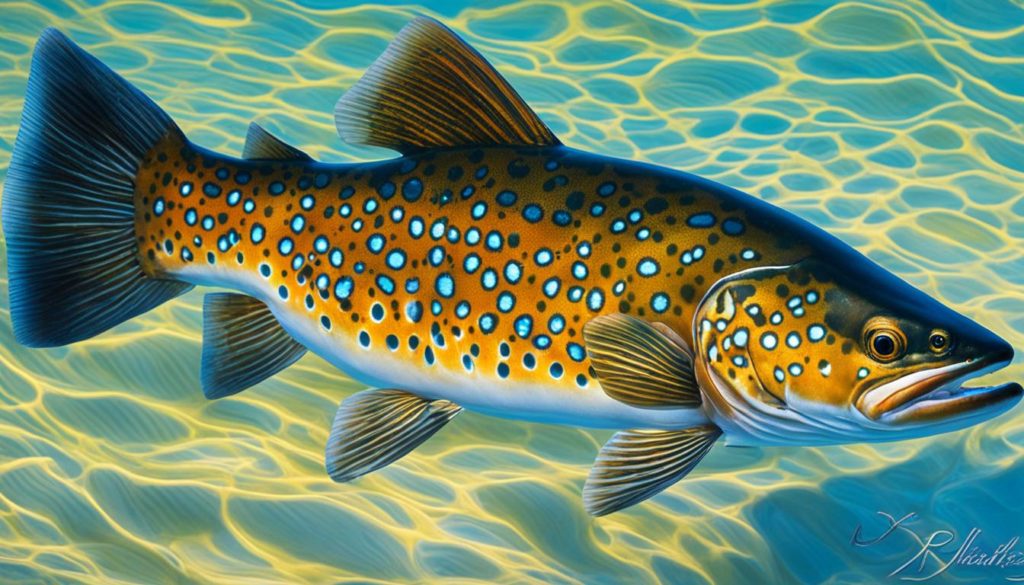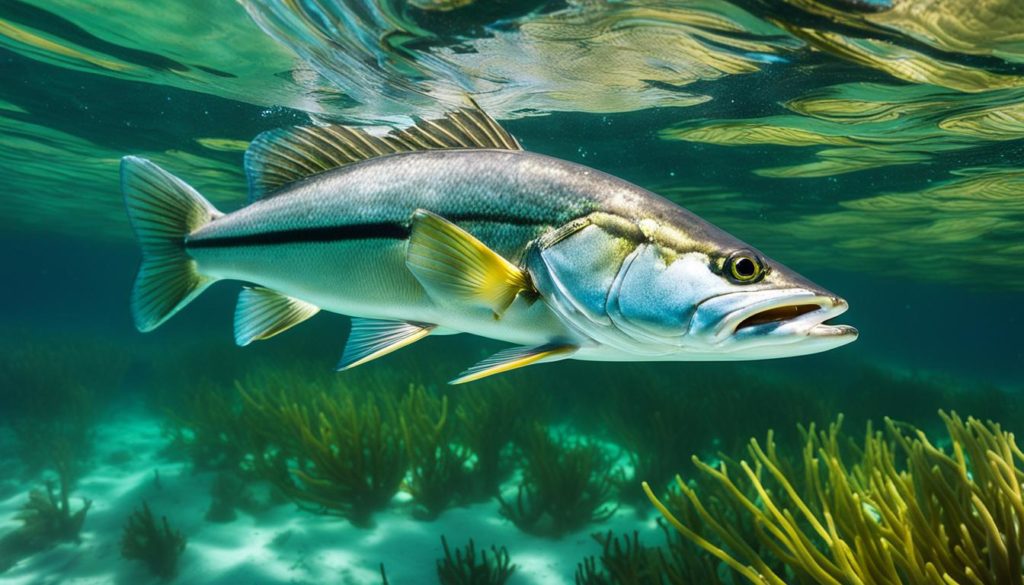Florida is a haven for anglers with its vast water resources. With over 7,700 lakes, 10,550 miles of rivers, and 2,276 miles of tidal shoreline, it’s no wonder that fishing is a popular activity in the state. Florida is also known for its diverse saltwater fish species that attract both locals and visitors. Whether you’re a seasoned angler or a novice, Florida offers a wide range of opportunities to catch common saltwater fish.
When it comes to saltwater fishing in Florida, there are various species of fish you can target. From the thrill of battling the mighty tarpon or sailfish to the joy of reeling in a red drum or snook, the options are endless. Each fish offers a unique fishing experience, whether you prefer the thrill of deep-sea fishing or the tranquility of fishing in the bay. So grab your fishing gear and get ready for an unforgettable fishing adventure in the Sunshine State.
Key Takeaways:
- Florida is a popular destination for saltwater fishing enthusiasts.
- The state offers a wide range of opportunities to catch common saltwater fish.
- Popular saltwater fish species in Florida include tarpon, sailfish, red drum, snook, and more.
- There are various fishing techniques and baits to target different saltwater fish species.
- Whether you’re a beginner or an experienced angler, fishing in Florida’s waters is an exciting adventure.
Top Saltwater Fish to Catch in Florida
Florida is renowned for its incredible saltwater fishing opportunities, attracting anglers from all over the world. With its diverse coastal habitats, from the vast ocean to the intricate bays and reefs, Florida is home to a wide variety of popular saltwater fish species. If you’re planning a fishing trip in Florida, here are some of the top fish species you should target:
Tarpon
Tarpon, also known as the “silver king,” is a highly sought-after gamefish in Florida. Known for their impressive size and acrobatic jumps, tarpon provide an exhilarating challenge for anglers. These majestic fish can be found throughout Florida’s waters and are known for their strength and endurance. To catch tarpon, anglers often use live bait, such as mullet or crab, and employ various techniques like drift fishing or sight casting.
Sailfish
Sailfish is Florida’s official state saltwater fish and a prized catch for any angler. With their stunning colors and remarkable dorsal fins, sailfish are a true marvel to behold. These fast and aggressive fish can be found in Florida’s tropical and subtropical waters, particularly in the Atlantic Ocean. Anglers often target sailfish by trolling with artificial lures or live bait, such as ballyhoo or mullet. The thrill of hooking into a sailfish and witnessing its acrobatic leaps is an unforgettable experience.
Spotted Sea Trout
Spotted sea trout, also known as speckled trout, is a popular sportfish in Florida. These fish are commonly found in the shallow waters of bays and estuaries, making them accessible to anglers of all skill levels. Spotted sea trout are opportunistic feeders and can be caught using a variety of baits, including live shrimp, artificial lures, and even flies. Their aggressive strikes and strong fight make them a favorite among Florida anglers.
Snook
Snook are prized gamefish known for their cagey nature and powerful runs. These fish are predominantly found in Florida’s warmer waters, such as the estuaries and mangrove shorelines. Snook can be targeted using a variety of baits, including live pilchards, shrimp, or artificial lures. Anglers often use stealthy approaches and accurate casts to entice these elusive fish. Hooking into a snook and experiencing its explosive strikes is a thrilling adventure for any angler.
These are just a few of the incredible saltwater fish species that you can catch in Florida. Whether you’re a seasoned angler or a novice, the diverse fishing opportunities in Florida offer something for everyone. So pack your fishing gear, head to the Sunshine State, and prepare for an unforgettable fishing experience.
Tarpon – The Silver King of Sportfish
Tarpon, also known as the “silver king,” is a highly prized gamefish in Florida. They are known for their powerful and acrobatic jumps, making them a favorite among anglers. Tarpon can tolerate different salinities and can be found throughout the state’s waters. While they are not valued as food, they provide an exciting challenge for anglers looking for a thrilling fishing experience.
The tarpon’s scientific name, Megalops atlanticus, translates to “giant marine leaper.” This species can grow up to 8 feet in length and weigh over 200 pounds. Their silver scales and large, toothless mouths make them easily recognizable. Tarpon can be found in both saltwater and brackish environments, including estuaries, bays, and nearshore waters.
Catching tarpon requires specialized techniques and equipment. Many anglers opt for fly fishing, using large, brightly colored flies to entice the fish. Live bait, such as mullet or crabs, can also be effective. It’s important to handle tarpon with care, as they are a protected species in Florida. Catch and release is encouraged to preserve their population and ensure future fishing opportunities.
| Tarpon Facts | |
|---|---|
| Scientific Name: | Megalops atlanticus |
| Size: | Up to 8 feet long and over 200 pounds |
| Habitat: | Saltwater and brackish environments |
| Feeding Habits: | Primarily feed on fish and crustaceans |
| Conservation Status: | Protected species in Florida, catch and release encouraged |
Did you know? Tarpon are known for their unique ability to gulp air at the water’s surface, allowing them to access oxygen in oxygen-depleted environments. This adaptation allows them to survive in areas with low oxygen levels, such as stagnant or brackish waters.
Whether you’re an experienced angler or a beginner looking for a challenge, targeting tarpon in Florida’s waters is an unforgettable experience. Their acrobatic jumps and sheer strength make them an exciting sportfish to pursue. So grab your gear, head to the water, and test your skills against the silver king!
Sailfish – Florida’s Official State Saltwater Fish
Florida’s waters are home to an array of incredible saltwater fish species, but one fish holds a special distinction – the sailfish. Recognized as Florida’s official state saltwater fish, the sailfish is a majestic and sought-after species that captivates anglers with its impressive dorsal fin and acrobatic leaps.
These magnificent creatures can be found in the tropical and subtropical waters of Florida, where they roam in search of their favorite prey. Sailfish are known for their speed and agility, making them a challenging target for even the most seasoned anglers.
To increase your chances of hooking a sailfish, it’s important to use the right techniques and equipment. Many anglers choose to troll with live bait, such as sardines or mullet, to entice these fast and aggressive fish. Others prefer to use artificial lures that mimic the movement of baitfish. Whichever method you choose, be prepared for an exhilarating battle when you hook into a sailfish.
“Catching a sailfish is an experience like no other. Their breathtaking jumps and powerful runs make every moment on the water unforgettable.” – experienced angler
| Common Name | Scientific Name | Size Range | Habitat |
|---|---|---|---|
| Sailfish | Istiophorus platypterus | 6 to 11 feet | Coastal waters, offshore reefs, and deeper offshore waters |
Spotted Sea Trout – Florida’s Popular Sportfish
Spotted sea trout, also known as speckled trout, is a highly sought-after sportfish in Florida. With its distinctive speckled appearance and aggressive nature, the spotted sea trout offers anglers an exciting and rewarding fishing experience.
These fish are commonly found in the shallow waters of bays and estuaries, where they feed on shrimp and small baitfish. Their preference for these habitats makes them accessible to both shore and boat anglers, providing a versatile fishing opportunity.
Anglers can target spotted sea trout using various techniques, including topwater plugs, soft plastic jigs, and live bait such as shrimp or mullet. The thrill of seeing a trout strike your lure and feeling its strong, darting runs is what makes fishing for spotted sea trout so exhilarating.
Table: Spotted Sea Trout Fishing Tips
| Fishing Techniques | Baits and Lures | Best Locations |
|---|---|---|
| Topwater Fishing | Topwater plugs | Grass flats, shallow bays |
| Jigging | Soft plastic jigs | Deep channels, drop-offs |
| Live Bait Fishing | Shrimp, mullet | Inlets, passes, mangrove edges |
| Fly Fishing | Saltwater flies | Flats, tidal creeks |
When targeting spotted sea trout, it’s important to consider the tidal movements and water clarity. These factors can influence the trout’s feeding behavior, so adjusting your approach accordingly can increase your chances of success.
Remember to check and comply with local fishing regulations regarding size and bag limits for spotted sea trout. This ensures the sustainability of the fishery and the preservation of this iconic sportfish for future generations to enjoy.
Snook – The Cagey Prey of Florida’s Waters
Snook, also known as the “cagey prey,” are highly sought-after gamefish in Florida. With their cunning nature and lightning-fast strikes, they present a formidable challenge for anglers. These sleek and silvery fish are known for their ability to outsmart even the most skilled fishermen, making every catch a thrilling and rewarding experience.
Found in Florida’s warmer waters, snook inhabit a variety of habitats, including mangrove shorelines, bridges, and inlets. They are known for their ambush hunting style and can be found hiding in the shadows, waiting for the perfect opportunity to strike. Patience and stealth are crucial when targeting snook, as they are easily spooked and have excellent eyesight.
When it comes to catching snook, anglers need to use a combination of skill, strategy, and the right bait. Live bait such as pilchards, shrimp, or finger mullet are popular choices, as they closely mimic the natural prey of snook. Artificial lures like topwater plugs and soft plastic jigs can also be effective in enticing these elusive fish. Successful snook fishing requires knowledge of the tides, currents, and the ability to read the water to locate their hiding spots.
Whether you are a seasoned angler looking for a challenge or a beginner wanting to test your skills, targeting snook in Florida’s waters is an unforgettable experience. The thrill of the hunt, coupled with the fierce fight these fish put up, will leave you with lasting memories and a deep appreciation for the beauty and tenacity of snook.
Red Drum – A Conservation Success Story
Red drum, also known as redfish, is a shallow-water schooling fish found in both salt and brackish water. These fish can be distinguished by their lack of chin barbels and a large black spot near the tail. Red drum were once heavily overfished, but conservation efforts have helped their population recover. Anglers can target red drum in both coastal and inland waters, and they provide a delicious meal.
Conservation Efforts
The decline of red drum populations in the past decades raised concerns among conservationists and led to the introduction of strict regulations to protect the species. Harvesting restrictions, size and bag limits, and seasonal closures have been put in place to allow red drum populations to rebuild. These conservation efforts have been successful, with red drum populations showing signs of recovery.
“The recovery of red drum populations is a testament to the effectiveness of conservation measures. It demonstrates the importance of sustainable fishing practices and the need to protect our marine resources for future generations.” – Conservationist
Fishing for Red Drum
Anglers can target red drum using a variety of techniques and baits. Live baits such as shrimp, mullet, and crab are popular choices, as well as artificial lures that mimic the natural prey of red drum. Red drum are known for their strength and fighting abilities, putting up a good challenge for anglers. When targeting red drum, it is important to adhere to fishing regulations and practice catch-and-release whenever possible to ensure the continued recovery of their populations.
| Red Drum Fishing Tips | Best Baits | Recommended Techniques |
|---|---|---|
| Fish during the early morning or late evening when red drum are most active. | Live shrimp, mullet, crab | Bottom fishing, casting near structure |
| Look for signs of red drum, such as tailing or feeding activity. | Artificial lures (soft plastics, spoons, topwater plugs) | Drifting, trolling, sight casting |
| Pay attention to tides and currents, as red drum often feed in areas with moving water. | Dead or cut bait (mullet, menhaden) | Popping corks, Carolina rigs |
By practicing responsible fishing and adhering to conservation measures, anglers can continue to enjoy the thrill of catching red drum while ensuring the long-term sustainability of this remarkable fish species.
Largemouth Bass – Florida’s Legendary Freshwater Fish
When it comes to fishing in Florida’s freshwater lakes and rivers, one fish stands out as a true legend – the largemouth bass. Known for its size and fighting abilities, the largemouth bass attracts anglers from all over the world who come to the Sunshine State in search of that trophy-sized catch.
Found in lakes and rivers throughout Florida, the largemouth bass can reach impressive sizes, with some specimens weighing over 10 pounds. These fish are known for their aggressive nature and will strike at almost anything that resembles prey, making them a thrilling target for anglers of all skill levels.
To increase your chances of catching a largemouth bass, it’s important to understand their behavior and habitat. These fish are often found near structures such as fallen trees, weed beds, and submerged rocks. They prefer calm, shallow waters and are more active during early morning and late afternoon.
Table: Largemouth Bass Fishing Techniques
| Technique | Description |
|---|---|
| Topwater Fishing | Using surface lures such as poppers or buzzbaits to entice bass to strike. |
| Spinnerbaits | Using spinnerbaits with flashy blades to mimic baitfish and provoke a reaction bite. |
| Plastic Worms | Using soft plastic worms rigged Texas or Carolina style to imitate a natural prey. |
| Jigging | Using lead-headed jigs with soft plastic trailers to fish deep structures. |
| Crankbaits | Using hard-bodied lures with a diving lip to cover large areas of water quickly. |
So whether you prefer the excitement of topwater strikes or the finesse of plastic worm fishing, there’s a technique that suits your angling style when it comes to targeting largemouth bass in Florida’s freshwater. Remember to check local fishing regulations and obtain the necessary licenses before heading out on your fishing adventure.
Panfish – The Mainstay for Young Anglers
If you’re a young angler looking to explore the world of fishing, panfish should be at the top of your list. These small and vibrant fish are the mainstay for many beginners, offering excitement and a great introduction to the sport. Found in lakes and rivers all across Florida, panfish provide endless opportunities for young anglers to hone their skills and create lasting memories.
Panfish encompass various species, including the spotted sunfish, bluegill, and redbreast sunfish. They are known for their willingness to bite and put up a spirited fight, making each catch a thrilling experience. Anglers can use a variety of baits, such as worms, popping bugs, and spinner baits, to entice panfish and reel them in.
One of the great advantages of targeting panfish is their abundance in Florida’s waters. This means that young anglers can have a high chance of success and catch multiple fish in a single outing. Not only does this boost confidence, but it also instills a sense of accomplishment and a love for the sport.
So, grab your fishing gear and head out to the nearest lake or river. With panfish as your target, you’re sure to have a memorable and enjoyable fishing adventure. Don’t forget to take a moment to appreciate the beauty of nature and the joy of angling, as these experiences will stay with you for a lifetime.
| Panfish Species | Preferred Baits | Preferred Fishing Techniques |
|---|---|---|
| Spotted Sunfish | Worms, small insects | Pole fishing, fly fishing |
| Bluegill | Worms, small jigs | Float fishing, casting |
| Redbreast Sunfish | Crickets, small spinners | Bottom fishing, baitcasting |
Grouper and Snapper – Bottom Dwellers of Florida’s Waters
When it comes to saltwater fishing in Florida, grouper and snapper are two fish species that anglers can’t afford to overlook. These bottom-dwelling fish offer a thrilling challenge and are highly sought after for their delicious meat. Let’s dive deeper into the world of grouper and snapper, and discover why they are such popular targets for anglers.
Grouper: The King of the Reef
Grouper is a generic name for several deepwater species found in Florida’s coastal waters. Some of the most sought-after grouper species include red grouper and gag grouper. These fish are known for their size, strength, and impressive fighting abilities. Grouper can reach weights exceeding 50 pounds, making them a true trophy fish.
Anglers typically target grouper using a technique called “bottom fishing.” This involves dropping baited hooks to the ocean floor and waiting for the grouper to take the bait. Common baits used for grouper fishing include live bait such as pinfish, grunts, or mullet, as well as cut bait like squid or mullet strips. Grouper can also be enticed by artificial lures designed to mimic their natural prey.
Snapper: The Colorful Prize
Red snapper is an offshore species found in deeper waters off the coast of Florida. They are known for their vibrant red color and delicious white meat. Red snapper is considered one of the finest food fish in Florida, and catching one is a prized achievement for any angler.
Anglers targeting red snapper often use a combination of live or cut bait and specialized rigs such as circle hooks or Carolina rigs. These rigs allow the bait to present naturally in the water, increasing the chances of enticing a snapper to bite. The key to successful snapper fishing is to locate areas with structure such as reefs, wrecks, or natural ledges that these fish like to inhabit.
| Grouper | Snapper |
|---|---|
| King of the reef | Colorful prize |
| Deepwater species | Offshore species |
| Size and strength | Vibrant red color |
| Bottom fishing | Specialized rigs |
Grouper and snapper are true gems of Florida’s waters, offering anglers an unforgettable fishing experience. Whether you’re battling a powerful grouper in the deep or reeling in a vibrant red snapper, these bottom-dwelling fish are sure to test your skills and provide a delicious reward. So, gear up, head out to the reefs or deep waters, and get ready to encounter these magnificent creatures of the sea.
Conclusion
Florida offers a wide range of opportunities for saltwater fishing enthusiasts. From the thrill of battling a tarpon or sailfish to the joy of catching a bass or panfish, there is something for every angler in Florida’s waters.
Whether you’re a beginner or an experienced angler, exploring the diverse saltwater fish species in Florida is a memorable experience. The state’s vast water resources, including lakes, rivers, and tidal shoreline, provide ample locations to cast your line and reel in a catch. With over 7,700 lakes, 10,550 miles of rivers, and 2,276 miles of tidal shoreline, there’s always a new spot to discover.
So grab your fishing gear and embark on a fishing adventure in the Sunshine State. Explore the stunning coastal waters, cast your line in the pristine lakes, or venture into the winding rivers. Whether you’re seeking excitement, relaxation, or simply the thrill of reeling in a big one, Florida has it all. Cast your line, feel the tug, and create lasting memories in Florida’s abundant fishing paradise.
FAQ
What are some common saltwater fish to catch in Florida?
Some common saltwater fish to catch in Florida include tarpon, sailfish, spotted sea trout, snook, red drum, largemouth bass, panfish, grouper, snapper, and mackerel.
Where can these saltwater fish be found in Florida?
These saltwater fish can be found in different habitats, such as the ocean, bays, and reefs, throughout Florida.
What techniques and baits can be used to catch these saltwater fish in Florida?
Different techniques and baits can be used to catch these saltwater fish in Florida. It depends on the specific fish species, but techniques such as bottom fishing, trolling, and fly fishing can be effective. Baits like live bait, artificial lures, and saltwater flies can also be used.
Are these saltwater fish good for eating?
Some of these saltwater fish, such as snapper and grouper, are considered delicious food fish. However, others, like tarpon, are not valued for their taste and are mainly caught for the thrill of the catch and release.
What is the best time of year to catch these saltwater fish in Florida?
The best time of year to catch these saltwater fish in Florida can vary depending on the species. Generally, spring and fall are considered prime seasons for many of these fish, but it’s always a good idea to research specific fish species and consult local fishing guides for the most up-to-date information.
Do I need a fishing license to catch these saltwater fish in Florida?
Yes, a fishing license is required in Florida for recreational fishing. Licenses can be obtained online or from various vendors throughout the state. Certain exemptions or discounted licenses may apply for residents, seniors, and military personnel.
What are the size and bag limits for these saltwater fish in Florida?
Size and bag limits for saltwater fish in Florida are designed to protect fish populations and ensure sustainable fishing. These limits can vary depending on the species and location. It’s important to check the latest fishing regulations issued by the Florida Fish and Wildlife Conservation Commission (FWC) or consult a local fishing guide for specific size and bag limit information.
Can I hire a fishing charter or guide to help me catch these saltwater fish in Florida?
Yes, hiring a fishing charter or guide is a great option for anglers who want expert guidance and the best chance to catch their desired saltwater fish. Florida is home to many experienced and knowledgeable fishing guides who can provide valuable tips and ensure a successful fishing trip.
Are there any restrictions on catch-and-release fishing for these saltwater fish in Florida?
Catch-and-release fishing is encouraged and widely practiced in Florida. However, it’s important to handle the fish with care and following best practices to minimize stress and increase the chances of survival after release. Using barbless hooks, wetting hands before handling the fish, and releasing the fish quickly are some of the recommended techniques for catch-and-release fishing.
What are some safety tips to keep in mind while saltwater fishing in Florida?
Safety should always be a top priority while saltwater fishing in Florida. Some safety tips to keep in mind include wearing a life jacket, checking the weather conditions before heading out, knowing the location of emergency services, avoiding overloaded boats, and being aware of any potential hazards in the water.




